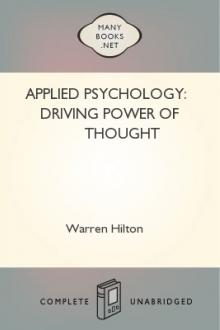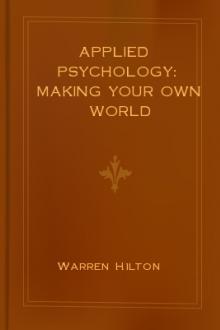Applied Psychology: Driving Power of Thought by Warren Hilton (smart books to read TXT) 📕

- Author: Warren Hilton
- Performer: -
Book online «Applied Psychology: Driving Power of Thought by Warren Hilton (smart books to read TXT) 📕». Author Warren Hilton
A Classifying Judgment associates and compares present and past sense-perceptions. It is the final process in the production of that marvel of the mind, the "idea."
The simple perception of a sensation unaccompanied by any other mental process is something that never happens to an adult human being.
In the infant's mind the arrival of a sense-impression arouses only a perception, a consciousness of the sense-impression. In the mind of any other person it awakens not only this present consciousness but also the associated memories of past experiences.
Upon the slumbering mind of the newborn babe the very first message from the sense-organs leaves its exquisite but indelible impress. The next sense-perception is but part of a state of consciousness, in which the memory of the first sense-perception is an active factor. This is a higher type of mental activity. It is a something other and more complex than the mere consciousness of a sensory message and the decision as to its source.
The moment, then, that we get beyond the first crude sense-perception consciousness consists not of detached sensory images but of "ideas," the complex product of present sense-perceptions, past sense-perceptions and the mental processes known to psychology as association and discrimination.
Every concrete conception or idea, such as "horse," "rose," "mountain," is made up of a number of associated properties. It has mass, form and various degrees of color, light and shade. Every quality it possesses is represented by a corresponding visual, auditory, tactual or other sensation.
Thus, your first sense-perception of coffee was probably that of sight. You perceived a brown liquid and your causal judgment explained that this sense-perception was the result of something outside of your body. Standing alone, this causal judgment meant very little to you, so far as your knowledge of coffee was concerned. So also the causal judgment that traced your sense of the smell of coffee to some object in space meant little until it was added to and associated with your eye-vision of that same point in space. And it was only when the causal judgment explaining the taste of coffee was added to the other two that you had an "idea" of what coffee really was.
When you look at a building, you receive a number and variety of simultaneous sensations, all of which, by the exercise of a causal judgment, you at once ascribe to the same point in space. From this time on the same flowing together of sensations from the same place will always mean for you that particular material thing, that particular building. You have a sensation of yellow, and forthwith a causal judgment tells you that something outside of your body produced it. But it would be a pretty difficult matter for you to know just what this something might be if there were not other simultaneous sensations of a different kind coming from the same point in space. So when you see a yellow color and at the same time experience a certain familiar taste and a certain softness of touch, all arising from the same source, then by a series of classifying judgments you put all these different sensations together, assign them to the same object, and give that object a name—for example, "butter."
This process of grouping and classification that we are describing under the name of "classifying judgments" is no haphazard affair. It is carried on in strict compliance with certain well-defined laws.
These laws prescribe and determine the workings of your mind just as absolutely as the laws of physics control the operations of material forces.
While each of these laws has its own special province and jurisdiction, yet all have one element in common, and that is that they all relate to those mental operations by which sense-perceptions, causal judgments, and even classifying judgments, past, present and imaginative, are grouped, bound together, arranged, catalogued and pigeonholed in the archives of the mind.
These laws, taken collectively, are therefore called the Laws of Association.
If there is any one thing in the world that seems utterly chaotic, it is the way in which the mind wanders from one subject of thought to another. It requires but a moment for it to flash from New York to San Francisco, from San Francisco to Tokio, and around the globe. Yet mental processes are as law-abiding as anything else in Nature.
So much is this true, that if we knew every detail of your past experience from your first infantile sensation, and knew also just what you are thinking of at the present moment, we could predict to a mathematical certainty just what ideas would next appear on the kaleidoscopic screen of your thoughts. This is due to laws that govern the association of ideas.
These laws are, in substance, that the way in which judgments and ideas are classified and stored away, and the order in which they are brought forth into consciousness depends upon what other judgments and ideas they have been associated with most habitually, recently, closely and vividly.
There are, therefore, four Prime Laws of Association—the Law of Habit, the Law of Recency, the Law of Contiguity and the Law of Vividness.
Every idea that can possibly arise in your thoughts has its vast array of associates, to each of which it is linked by some one element in common. Thus, you see or dream of a yellow flower, and the one property of yellowness links the idea of that flower with everything you ever before saw or dreamed of that was similarly hued.
But the yellow-flower thought is not tied to all these countless associates by bonds of equal strength. And which associate shall come next to mind is determined by the four Prime Laws of Association.
The Law of Habit requires that frequency of association be the one test to determine what idea shall next come into consciousness, while the Laws of Recency, Contiguity and Vividness emphasize respectively recency of occurrence, closeness in point of space and intensity of impression. Which law and which element shall prevail is all a question of degree.
The most important of these laws is the Law of Habit. In obedience to this law, the next idea to enter the mind will be the one that has been most frequently associated with the interesting part of the subject you are now thinking of.
The sight of a pile of manuscript on your desk ready for the printer, the thought of a printer, the word "printer," spoken or printed, calls to mind the particular printer with whom you have been dealing for some years.
The word "cocoa," the thought of a cup of cocoa, the mental picture of a cup of cocoa, may conjure with it not merely a steaming cup before the mind's eye and the flavor of the contents, but also a daintily clad figure in apron and cap bearing the brand of some well-known cocoa manufacturer.
If a typist or pianist has learned one system of fingering, it is almost impossible to change, because each letter, each note on the keyboard is associated with the idea of movement in a particular finger. Constant use has so welded these associations together that when one enters the mind it draws its associate in its train.
Test the truth of these principles for yourself. Try them out and see whether the elements of habit, contiguity, recency and intensity do not determine all questions of association.
If you wanted to buy a house, what local subdivision would come first to your mind, and why? If you were about to purchase a new tire for your automobile or a few pairs of stockings, what brand would you buy, and why? When you think of a camera or a cake of soap, what particular make comes first to your mind? When you think of a home, what is the mental picture that rises before you, and why?
Whatever the article, whether it be one of food or luxury or investment, or even of sentiment, you will find that it is tagged with a definite associate—a name, a brand, or a personality characterized by frequency, recency, closeness or vividness of presentation to your consciousness.
The grouping together of sensations into integral ideas is one step in the complicated mental processes by which useful knowledge is acquired. But the associative processes go much beyond this.
We also compare the different objects of present and past experience. We carefully and thoroughly catalogue them into groups, divisions and subdivisions for convenient and ready reference. This we do by the processes of memory, of association and of discrimination, previously referred to.
Through these processes our knowledge of the world, derived from the whole vast field of experience, is unified and systematized. Through these processes is order realized from chaos. Through these processes it comes about that not only individual thought, but the communication of thought from one person to another, is vastly simplified. Language is enabled to deal with ideas instead of with isolated sense-perceptions. The single word "horse" suffices to convey a thought that could not be adequately set forth in a page-long enumeration of disconnected sense-perceptions.
The associative process covers a wide range. It includes, for example, not only the simple definition of an aggregate of sense-perceptions, as "horse" or "cow"; it includes as well the inferential process of abstract reasoning.
The only real difference between these widely diverse mental acts, one apparently so much less complicated and profound than the other, is that the former involves no act of memory, while the latter is based wholly on sensory experiences of the past.
Abstract reasoning is merely reasoning from premises and to conclusions which are not present to our senses at the time.
It is a recognized fact of observation that Every idea has a certain emotional quality associated with it, a sort of "feeling tone."
If ideas of health and triumphant achievement are brought into consciousness, we at the same time experience a state of energy, a feeling of courage and capability and joy and a stimulation of all the bodily processes. If, on the other hand, ideas of disease and death and failure are brought into consciousness, we at the same time experience feelings of sorrow and mental suffering and a state of lethargy, a feeling of inertia, impotence and fatigue.
Exalted ideas have associated





Comments (0)